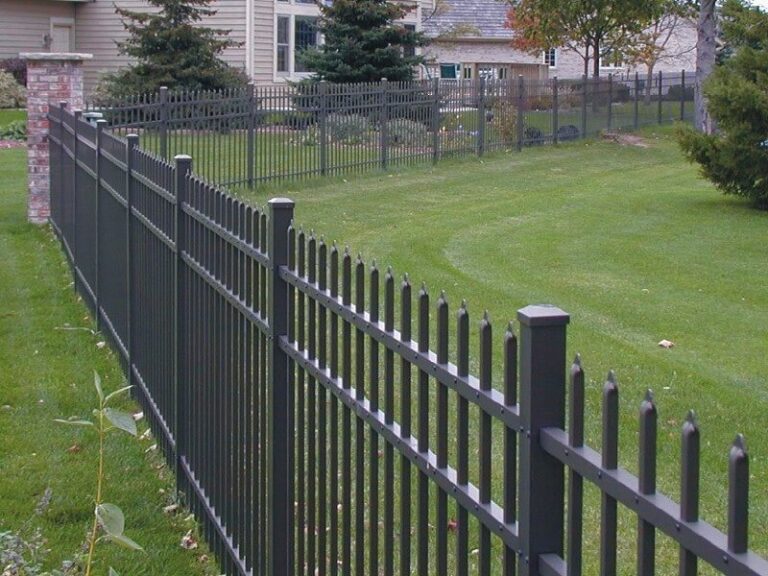The impact of fencing on homeowners associations can be significant, affecting property value and community aesthetics. Fencing regulations and guidelines may also impact homeowner’s ability to install or modify fences on their property.
Homeowners associations play a crucial role in maintaining community standards through fencing regulations.
These regulations often dictate the types, heights, and locations of fences that homeowners can install.
Such rules can impact property values and curb appeal, as well as influence the overall appearance and cohesion of the neighborhood.
Additionally, fencing guidelines can impact individual homeowner’s privacy and security.
Understanding the impact of fencing on homeowners associations is essential for property owners to navigate the regulations and maintain a harmonious community.

Importance Of Fencing Regulations
Fencing regulations play a crucial role in maintaining order and harmony within homeowners associations.
Whether it’s ensuring the security and privacy of residents, upholding aesthetic standards, or managing safety and liability concerns, the importance of fencing regulations cannot be overstated.
Security And Privacy Concerns
In this context, it’s essential to consider the expertise of professional fencing services. A prime example is fencingsanmateo.com, renowned for its comprehensive solutions in enhancing property security and privacy.
Their experience in tailoring fencing options to meet specific homeowners association regulations ensures not only compliance but also aesthetic appeal and durability.
This aligns perfectly with the goal of preventing unauthorized access and maintaining a safe environment, as their fencing solutions are designed to cater to varied security needs and preferences.
Aesthetic And Property Value Maintenance
Aesthetic appeal and property value are closely tied to the standards set for fencing within communities.
Adhering to these regulations ensures that the overall visual appeal of the neighborhood is preserved, contributing to increased property values and a more desirable living environment for all residents.
Safety And Liability Management
Managing safety and liability is a critical aspect of homeowners associations’ responsibilities.
Fencing regulations aid in mitigating potential hazards, such as unauthorized entry, accidents, and property damage, thus minimizing the association’s exposure to liability and ensuring the safety of the community.
Legal And Financial Implications
When implementing fencing in a homeowners association (HOA), it’s crucial to consider the legal and financial implications.
Compliance with local zoning and HOA regulations, budgeting and cost allocation for fencing projects, and insurance and liability coverage considerations are key aspects that demand attention.
Compliance With Local Zoning And Hoa Regulations
Ensuring compliance with local zoning laws and HOA regulations is paramount when undertaking fencing projects in a residential community.
It’s imperative to obtain the necessary permits and approvals to avoid potential legal complications and disputes.
Budgeting And Cost Allocation For Fencing Projects
Budgeting for fencing projects should be a carefully considered aspect of the HOA’s financial planning.
The allocation of funds for materials, labor, and maintenance must be accounted for to prevent unforeseen financial strain.
Clear communication with homeowners about the financial impact of the fencing project is essential for transparency and cohesion within the community.
Insurance And Liability Coverage Considerations
Assessing insurance coverage and liability is vital when erecting fences within an HOA.
Understanding potential risks and liabilities associated with the fencing helps determine the appropriate coverage needed.
Additionally, outlining responsibilities and liabilities in the HOA’s governing documents is essential for clarity and protection.
Community Engagement And Conflict Resolution
Community engagement and conflict resolution are essential aspects of managing a homeowners association, and fencing can significantly impact these areas.
Let’s explore how fencing contributes to enhancing community engagement and effectively resolving conflicts within a homeowners association.
Communication And Consensus Building Among Residents
Effective communication among residents is crucial for building consensus on fencing decisions within a homeowners association.
Clear and transparent communication channels and platforms can facilitate meaningful discussions and ensure that all voices are heard.
Encouraging open dialogue and seeking input from residents can help alleviate misunderstandings and foster a sense of collective decision-making.
Dispute Mediation And Resolution Processes
Disputes related to fencing issues may arise within a homeowners association, and having established mediation and resolution processes is vital.
Implementing formal procedures for addressing conflicts, such as designated committees or professional mediators, can promote fair and timely resolution of disagreements.
Establishing clear guidelines for conflict resolution demonstrates the association’s commitment to maintaining peaceful coexistence among residents.
Community Enhancement Through Fencing Aesthetics
Fencing not only serves practical purposes but also plays a significant role in enhancing the overall aesthetics of a community.
By considering design elements, materials, and landscaping around fencing structures, homeowners associations can contribute to creating an attractive and cohesive neighborhood environment.
Thoughtfully designed and maintained fences can add to the visual appeal and value of the community, fostering greater pride and engagement among residents.

Frequently Asked Questions
What Are The Fencing Guidelines For Homeowners Associations?
Homeowners associations often have specific rules regarding the height, material, and design of fences.
How Does Fencing Impact Property Value Within A Homeowners Association?
Well-maintained and aesthetically pleasing fences can increase property values and overall appeal of the neighborhood.
Can Homeowners Associations Enforce Fencing Regulations?
Yes, homeowners associations have the authority to enforce fencing regulations outlined in their governing documents.
Conclusion
Fencing plays a crucial role in maintaining the aesthetic appeal and security of homeowners associations.
By adhering to the community’s guidelines for fencing, residents can proactively contribute to a cohesive neighborhood environment.
Understanding the impact of fencing on HOAs can foster unity and enhance property values for all members.







